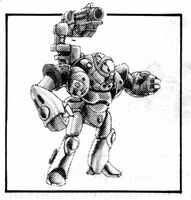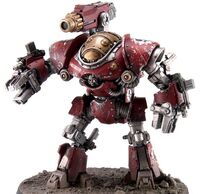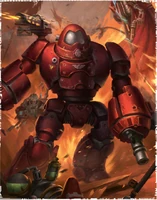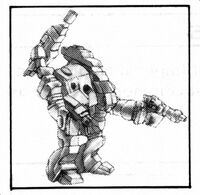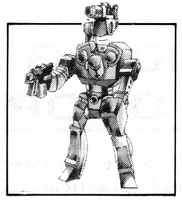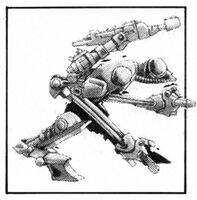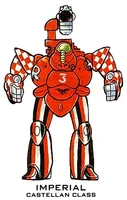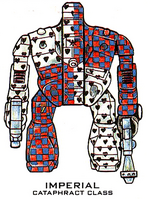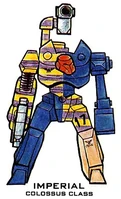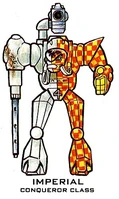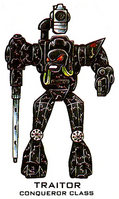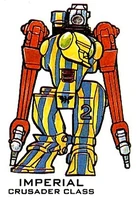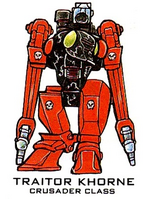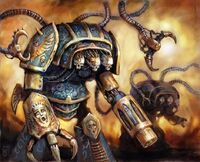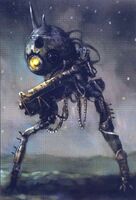"The Legio Cybernetica is a treasured facet of the Mechanicum. The Great Crusade leans heaviest on the Legio Titanicus for their war engines, but Cybernetica plays its role among the noblest Astartes Legions. Their artificials are robotic shells housing Machine Spirits. Cybernetica Tech-priests engineer organic-synthetic minds from biological components."
- — Seventh Captain Argel Tal, commander of the Word Bearers Space Marine Legion's Serrated Suns Chapter
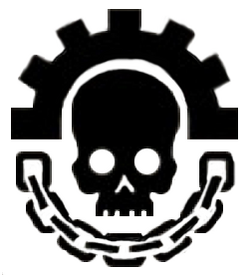
Iconography of the Legio Cybernetica
The Legio Cybernetica is one of the oldest sub-branches of the Adeptus Mechanicus and is responsible for deploying fully autonomous Battle-Automata for both combat duties and support tasks intended to aid Imperial armed forces in the field.
The Legio Cybernetica can trace its lineage to the time before the birth of the Imperium of Man when Mars was an independent empire ruled by the Tech-priests of the Cult Mechanicus. Its members regard themselves as an elite within the ranks of the Mechanicus, as their Legio has a long history of serving the will of the Emperor of Mankind. However, many of those within the Legio broke faith with the Emperor during the Schism of Mars, siding with the traitorous forces of the Warmaster Horus and fighting alongside his Traitor Legions throughout the Horus Heresy.
When this conflict ended the Traitor cohorts of the Legio Cybernetica fled into the Eye of Terror, where they remain to this day, warped and twisted by their exposure to the power of Chaos. The remaining Loyalist elements of the Legio Cybernetica pledged themselves anew to the Imperium, and its members took binding oaths of loyalty more terrible than any taken even by the Astartes.
The Legio Cybernetica traces its origins to when early tech-savants experimented with artificial life during the Age of Technology. Ever curious, those early pioneers not only constructed vast hosts of automatons but also gave their creations the gift of independent thought. That decision was to cost them dearly, and the rest of Humanity with them. After the terrible consequences of those times, the dread concept of the Silica Animus was outlawed forever, its creators subjected to excommunico fatalis and its resurrection punishable by torture to the point of death.
And yet there were those that still yearned to walk in their shadow, to perfect a thinking machine. In lieu of creating automata with the souls of men, many recidivist Tech-priests created machines imbued with the animus of loyal beasts -- or worse, with essences from the Empyrean. This too had disastrous consequences.
The resultant schism was exploited by Horus himself when he betrayed the Emperor. Its legacy survived with the Dark Mechanicum, whose members still go to infernal lengths to give life to their machines. Many later-pattern robots are tainted by their association with the machine-predators of that desperate age.
So it is that in the 41st Millennium the animalistic Thanatar, Castellax and Vorax Patterns of Battle-Automata are forgotten on all but the most intrepid and independent of Forge Worlds, and the Dark Mechanicum spoken of only in whispered code. Yet the fear and dark legend of those unstoppable robot armies lives on.
Yet, over the millennia since the Heresy, the Legio Cybernetica has regained the respect and admiration of the rest of the Adeptus Mechanicus as well as the other myriad Adepta of the Imperium, though in fact it has rarely been deployed in recent centuries.
Legio History[]
"The beast of metal endures longer than the flesh of men. Those that tend the beast of metal must labour long to learn its ways, for a single beast must suffer the mastership of many men until ready to shed its last vorpal coil."
- — Introit to Runic Mechanics
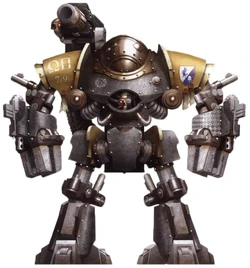
A Castellax-class Battle-Automata, designated Omega Pi Seven, seconded to the Legio Gryphonicus at the First Battle of Paramar during the Horus Heresy
One of the most feared and powerful of the Legiones Militant of the Adeptus Mechanicus, the Legio Cybernetica carries the onerous burden and dread responsibility of the use of Battle-Automata in warfare, as well as the development, propagation and maintenance of these terrifying machines under sacred charge of the Crimson Accord of Mars.
These sacred accords were one of the cornerstones of doctrinal law created at the foundation of the ancient Mechanicum during the Age of Strife, and forever forbade the creation of the abominable and soulless artificial general intelligence (A.I. or "Abominable Intelligence") known as the Silica Animus, and pronounced a death sentence on any who remained or any Magos or mortal who would seek to create them anew.
These accords, however, allowed the survival and creation of the "lesser and righteous works" of synthetic life still deemed sacred, the Bestia Mechanica and their kindred, and of these robotic engines designed for warfare and slaughter, the Battle-Automata, were given into the hands of the newly-founded Legio Cybernetica to control.
Great Crusade[]
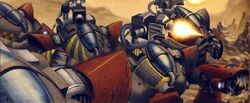
Castellan-class Imperial robots of the Legio Cybernetica's Maniple Gamma Rho attack the foe
The service of the Legio Cybernetica on the field of battle was part and parcel of the Mechanicum's treaty of union with the Emperor, known as the Treaty of Mars (called the Treaty of Olympus Mons by the Mechanicum), and a great many cohorts transferred from duties as defenders of the Forge Worlds and retainers of the great Mechanicum factions and sects to act as mendicant regiments in the Great Crusade, fighting on every battlefield imaginable and serving many masters.
Although their Battle-automata were difficult to construct and maintain, the arcane lore of the Legio Cybernetica's Magos and the successes they enjoyed on the battlefield ensured that several thousand active Cohorts of the Legio Cybernetica were in existence at the outbreak of the Horus Heresy. The Legio was instrumental in ending the isolation that had consumed the human-settled galaxy during the long years of the Age of Strife. This massive expansion of the Imperium continued unabated until the Emperor's realm encompassed nearly the entire galaxy by the start of the second century of the 31st Millennium.
Unfortunately, a new and unexpected threat emerged to challenge Mankind's dominance over the galaxy. A galaxy-wide interstellar revolt was instigated and led by the Warmaster Horus, the greatest and most beloved of the Emperor's Primarchs, his super-human, genetically-engineered sons. But even before the opening stages of his planned insurrection began, he knew he would have to secure the support of the Adeptus Mechanicus and their superior technology and weapons if he was to defeat the Emperor and conquer the galaxy.
Schism of Mars[]
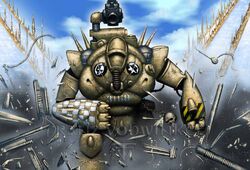
A Legio Cybernetica Castellan-class robot supports the Space Wolves Legion during the Burning of Prospero
In order to win over the loyalty of the Adeptus Mechanicus, Horus promised he would provide them with the lost secrets of ancient Standard Template Construct (STC) technology that had been recovered from the worlds of the recently subjugated Auretian Technocracy by his own Sons of Horus Legion. Convincing the Fabricator-General Kelbor-Hal of his resolve, the Warmaster secured the traitorous Arch-Magos' support by promising to provide increased autonomy for the Mechanicus after his victory, repealing all of the rules against the development of certain technologies that had been placed upon the Mechanicus by the Emperor.
As a gesture of gratitude for his support, Horus supplied the Fabricator-General with the information needed to open the sealed Vaults of Moravec -- a repository of forbidden technology and innumerable artefacts corrupted by the malign influence of Chaos. The Emperor had ordered this repository sealed two centuries earlier, after the signing of the Treaty of Mars that incorporated the Mechanicus into the newborn Imperium. Their dark bargain struck, the Fabricator-General pledged his continued support for Horus, and promised that the Mechanicus would assist the Traitors with all the technology and war materiel at their disposal.
Eventually civil war erupted across the Red Planet, as the tense relations between the various Mechanicum Magi who governed Mars erupted overnight into open civil conflict between those who remained Loyal to the Imperium and those who supported Kelbor-Hal and the Traitors. When the Fabricator-General and his Dark Mechanicum forces moved against the Loyalist factions, the robot cohorts under the command of the Legio Cybernetica willingly obeyed their traitorous masters.
In the subsequent fighting, many more of the Mechanicum soon joined Horus and his Traitors, not bothering to hide the fact that parts of the Legio had been the first to declare for the Warmaster. The independent nature of the Legio Cybernetica's cohorts ensured that, as a whole, they sided in particular neither with Loyalist or Traitor, but were split between masters they had long fought for in many cases.
Other cohorts, mindful of their oaths of loyalty to the Emperor and fearful of descent into anarchy, saw the Traitors as base Renegades to be destroyed, while others harboured ambitions to be free of the strictures of the Crimson Accords, and saw Horus' war as a chance to pursue the development of long-forbidden technologies.
Following the defeat of Horus at the hands of the mortally-wounded Emperor at the end of the Battle of Terra, and the banishment of the Traitor Legions to the Eye of Terror, those within the Legio Cybernetica who had sided with the Traitors fled in disgrace as well. There they have remained for the last ten millennia, gradually becoming ever more warped and distorted by the power of Chaos.
Legio Cybernetica Organisation[]
"In Aeternem Ferra Mortis."
- — Maxim Cybernetica, translated into Low Gothic as, "In eternal iron death."
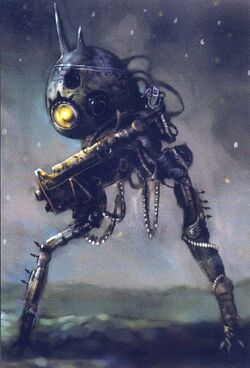
A Rho-Tau 17 Surveillance Robot
Wary of the power these supreme killing machines could wield if joined together -- power enough to overthrow empires as they had done in the dark times of the Age of Strife -- it was decreed from the beginning that the Legio Cybernetica would be broken down into a myriad of self-contained and relatively small independent units known as "cohorts."
This effectively limited the power wielded by any single Archmagos of the Legio; the destructive power of the cohort resting in an array of between 30-100 Battle-automata maniples, each comprising between one and five of the sacred war engines. Each cohort was governed by a senior priest of the Machine Cult with whom the secret lore of the cybernetica resided, and below them a covenant of Magos Dominus who would govern the war machines themselves in the thick of battle, Myrmidons sworn to the cohort's service and their own Enginseers, Servitors and thralls who would see to the cohort's needs both on and off the battlefield.
The cohorts also commanded their own support networks, mobile workshops, transports, battlefield vehicles, orbital landers and even star vessels in some cases, but were otherwise forbidden to found their own forges or chantries, making them dependant on webs of fealty, supply and patronage from the great Machine Lord of the Mechanicum and its Forge Worlds for their long-term survival and prosperity.
The Legio Cybernetica specialises in only one of the myriad areas of technical arcana, primarily the care and construction of all robots throughout the Imperium. Once employed by the forces of the Imperial Army and the Space Marine Legions as combat and labour support, they are now exclusively deployed by the Legio.
In their heyday, the Legio Cybernetica was organised into several thousand cohorts, although only a small percentage of these were ever active at any given time. Each of these robot cohorts were in turn organised into maniples of 3, 4 or 5 robots led by a Legio Tech-adept. Numbering rarely more than 100, the number of maniples within a cohort could greatly vary.
However, a cohort was usually spread across an entire Astartes force of several Chapters or a single large Imperial Army force. The use of more than 4 or 5 maniples in a battle were rare, but not unknown. During the Horus Heresy particularly large numbers of Legio robots were committed by both the Loyalists and Traitors in an effort to minimise human casualties until a decisive final battle could be fought. In addition, the Legio was further divided into a number of sects.
Each maniple was a self-contained unit, with a single Tech-adept typically overseeing the management of four robots on the battlefield. They were responsible for little more than providing the robots with their final "wetware" programming and for monitoring their progress during combat.
However, they were also charged with the equally vital task of monitoring the overall progress of their maniple, and to ensure that a damaged robot was destroyed as quickly as possible, to avoid any possible danger a malfunctioning automaton could present to their own side in the battle. This was done by remotely activating the robot's self-destruct system.
There were also a number of other, lesser Tech-adepts who performed all maintenance and repair functions for the maniple in between combat operations Their presence on the battlefield was rare but did occurr in certain situations. Possessing the ability to repair virtually any item of Imperial equipment, it was said these Tech-adepts of the Legio were worth their weight in spares.
Members of the Legio Cybernetica tended to eschew the gross cybernetic augmentations of their colleagues within the Mechanicus in favour of subtle bionic enhancements that do not disfigure or dilute their outwardly human aspect; but those who know a member of the Legio know that whatever humanity they do show is rare and fleeting. Those of senior rank or equally high status are known to wear the circuit-laced robes of a Mech-Lord to identify their esteemed status. These senior Legio members are usually accompanied by a small maniple of robots for their own personal protection.
Legio Cybernetic Personnel[]
Magos Dominus[]
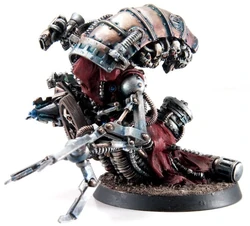
A Magos Dominus of the Legio Cybernetica
The Magos Dominus, also called a Tech-priest Dominus, is a master of the arts of the Legio Cybernetica, a sect of the priesthood of Mars granted the dread right to create and control the cortex-automata built for war and based upon the terrible secrets of the Dark Age of Technology. Such strange and threatening powers are not without price, and by doctrinal tradition such individuals surrendered an easy route to power within the Mechanicum, so dangerous did their fellows consider the secrets they wield.
Instead Magi Dominus and their acolytes formed but one of the many factions and sects within the Mechanicum, divided both by technological specialisation as well as rivalry and ancient feud, each vying for power, knowledge and resources beneath the outward unity the organisation displays, shrouded as it is by impenetrable mystery and arcana.
Those found within the ranks of the Taghmata serve a vital role but are seldom the most powerful of their kind, who can instead be found in the command of the Legio Cybernetica. Instead they served the Magos Prime either under terms of personal fealty or in fulfilment of binding pacts of mutual support between their Legio Cybernetica cohort and the Archimandrite who stands as the power behind the Taghmata.
Cybernetica Datasmiths[]
Cybernetica Datasmiths are the specialist rank of Tech-priest that program the Kastelan Robots of the Legio Cybernetica at the maniple level, often having to do so in the thick of battle. They have access to the dizzying array of weapons and arcana of their Forge World's arsenals, which they use in defence of themselves and their charges.
Since the aftermath of the Warmaster Horus' rebellion, the Legio Cybernetica's robots have been controlled completely by their masters -- not by the bio-plastic cerebra and nerve-like tendril webs of Mechanicum constructs, but by sanctified doctrina wafers, fusions of bio-matter and electronics often in even shorter supply than the robots themselves. No bigger than the cards of the Emperor's Tarot, these slivers of wetware are entrusted to the Cybernetica Datasmiths that accompany the robot maniples to war.
Inserted into the dataslot hidden behind each robot's chestplate, the wafer's command protocol will dictate every iota of the host's behaviour, usually optimising its ability to destroy its foes in a spectacular fashion. If the accompanying Datasmith wishes to change the behaviour of his robotic charges -- for instance to the assault-oriented Conqueror protocol -- he must manually remove the first doctrina wafer and insert a new one in its place.
Should a maniple of robots find itself in battle mode without a Datasmith, it will continue to prosecute its last doctrina protocol until it runs out of power -- something that usually takes solar weeks of unbridled slaughter to achieve. Such risks and limitations are willingly accepted by the Cult Mechanicus, for the act of hardwiring independent thought into a battle automaton is strictly forbidden.
Imperial Robots[]
Over the centuries the Legio Cybernetica has produced many robot designs. Many proved to be successful, and the Legio has kept the five most common Imperial battle robot designs in its inventory for most of the Imperium's long and bloody history.
Some of these designs were utter failures, such as the disastrous Castigator-class, which was so heavily armoured it moved slower than the troops it was designed to protect and support. Its survival capability was negligible as it was only outfitted with meagre weapons; a single Bolter.
Robot Patterns[]
- Baharat - The Baharat-class robot was designed for battling many unarmored foes at once. Standing at four metres tall, it is a mass of metal and muscle with two shoulder-mounted rotary autocannons, its featureless facemask looking down upon its foes as it mows them down with an unrelenting barrage.
- Castellan - The Castellan-class robot was designed for general-purpose combat and assault and is also ideally suited for a wide-range of battlefield situations. It is armed with a Power Glove on each arm as well as a Heavy Bolter mounted above its chassis for additional protection and ranged firepower. This standard configuration makes it particularly effective in siege and anti-vehicle roles, and provides an effective compliment to heavy weapon armament.
- Castellax - The most common pattern of the widespread Castellan-type battle-automata in service, the Castellax is a general battle unit developed during the Great Crusade from its ancient forebear. Primarily intended for siege work and shock assaults, the Castellax Battle-automata is a hulking humanoid machine with a notoriously aggressive and responsive Machine Spirit, and an enviable reputation on the battlefield. The Castellax, employed in units of one to five by the Legio Cybernetica, has a standard configuration of Bolter and Bolt Cannon armament, and is able to maintain a punishing barrage of firepower as it advances.
- Kastelan - A huge, ancient robot class built ten thousand years ago, the Kastelan Robot is a perfect example of the Adeptus Mechanicus' repurposing of technology. Nearly unstoppable, their only flaw is that of any mere machine; they will follow instructions to the letter, even if this results in their own demise. A specialist Tech-Priest -- the Cybernetica Datasmith -- must constantly update and reprogram the Kastelan via order dataslates, lest this enormous, clanking robot simply stride blindly into a nearby chasm. Make no mistake, however; when his controls are set to destroy, the Kastelan will destroy. The Kastelan Robots are armed with such options as two sets of Power Fists or a pair of twin-linked Phosphor Blasters, and a choice of carapace-mounted weaponry, either a Incendine Combustor or yet another Phosphor Blaster.
- Cataphract - The Cataphract-class robot is a heavily-armoured general-purpose battle robot designed for use in almost all combat environments and situations. This versatility in a wide range of battlefield roles makes this war engine a highly-deployable and popular machine among the Legio Cybernetica's cohorts. This robot can mount a variety of weapons for various purposes, the most common being one Lascannon above its chassis and a Bolter mounted on one arm and one Flamer mounted on the other. It is often regarded by some Imperial commanders as a jack-of-all-trades.
- Colossus - The Colossus-class robot was designed to function primarily as a siege weapon. Its standard configuration combines a Siege Hammer mounted one of its arm appendages for attacking fortifications with a Bolter mounted on its other arm appendage for use against defending troops. The Siege Hammer can also be used in close combat situations. It also possesses a chassis-mounted Multi-Melta for additional firepower. The Colossus is often employed by the Imperial Guard as a cheap alternative to the use of heavy artillery. A few Colossus-class robots are maintained by the Ordo Reductor of the Adeptus Mechanicus, mainly for testing new and experimental siege weaponry.
- Conqueror - The Conqueror-class robot was designed for use in battlefield situations where heavily-armed resistance is expected. Its combination of potent firepower combined with heavy armour is a major benefit of its design. On one of its arms is mounted an Autocannon, on the other a Power Fist. Above its chassis is mounted a Heavy Bolter for additional firepower. The Conqueror is ideally suited for assault, anti-vehicle and anti-Dreadnought roles on the battlefield.
- Domitar - Accorded by most observers to be the last class of battle-automata to enter production on multiple Forge Worlds before the outbreak of civil war, the Domitar was a sophisticated variant of the ancient Conqueror pattern. Larger than the more common Castellax alongside which it would serve, the Domitar was also swifter, designed to cross the open battlefield at speed, and built expressly to crash into the enemy with shattering force. To this end the Domitar's shock-protected and armoured frame was itself a weapon, while its blows were amplified to colossal proportions by the battle-automata's inbuilt gravitational hammers, allowing it to pulverise battle tanks and, as it would later prove, even Legiones Astartes Dreadnoughts in combat. As a line-breaker, the Domitar was unparalleled in the Mechanicum's arsenal, and its tactical flexibility was further augmented with a missile launcher armed with a variety of munitions.
- Crusader - The Crusader-class robot is designed for agility, as it can move quickly on the battlefield and strike a telling blow. It is a light combat robot, and it is only lightly-armoured. It is most often employed in an anti-personnel mode, and has proven to be very popular with the forces of the Inquisition and other groups like the Adeptus Arbites, due to its effectiveness in mutant-hunter/killer operations. The Crusader is never used where heavy resistance or strong concentrations of enemy armour are expected. The Crusader is typically armed with dual Power Swords on each arm, and a chassis-mounted Lascannon.
- Vorax - The Vorax-class battle-automata is a hunter-killer unit created from the ancient and revered Crusader template pattern said to date back to the Dark Age of Technology and which may be found on every major Forge World in the Imperium. Created on pre-Imperial Mars to fulfil the roles both of search and destroy weapon and exterminator of rogue machines and mutant vermin, their Cybernetica cortex engrams are known to be particularly predatory and vicious examples of their kind. Such are the bestial instincts that sleep within their blast-steel and ceramite bodies that numerous cut-outs and override cantos are hard-wired into their control programming to prevent these tireless hunting machines from devolving into becoming like the renegades they prey upon in the shadows of the great forge-fanes on Mars. Armed with a pair of rotor cannon and a lightning gun, the Vorax are prepared to meet most threats. At close quarters their battle-automata power blades make short work of even heavily armoured infantry units.
- Scyllax - No larger than an armoured man, the Scyllax Guardian-automata demonstrates formidable power in a more compact frame. These sophisticated machine-creatures are neither a true battle-automata, lacking a cybernetic-cortex, nor are they a true-Servitor class as their organic component is almost negligible, reduced to the ossuary skulls and human neural tissue harvested from sources best left unknown. Their armoured carapaces, as durable as Adeptus Astartes battle plate, house instead powerful electro-thermic reactors and banks of lucid cogitator-stacks that process a storm of battlefield analysis engrams and protective tech-incantations, a system so potent some claim it borders on the blasphemy of the Silica Animus. Prized far beyond the servo-automata from which they were developed using ancient secrets uncovered during the Great Crusade, Scyllax are found in the retinues of only the highest ranking magos, where they serve as bodyguards and elite shock troops. Though there are some factions within the Adeptus Mechanicus who will have no truck with the Scyllax, claiming sinister provenance for its design, and that the automata gain a subtle and dangerous self-awareness over time.
- Thanatar - The Thanatar-class Siege Automata is a heavy class Imperial robot utilised by the Legio Cybernetica during the Great Crusade and Horus Heresy eras of the late-30th and early 31st Millennia. Designed as a mobile artillery platform rather than a general battle unit, it is armed with a Hellex Pattern Plasma Mortar. This is a terrifying weapon able to launch dense spheres of blazing plasma on arcing trajectories over defensive barriers and into the heart of enemy fortifications, incinerating anything in their blast radius with a liquid tide of sun-hot fire. The Thanatar's frame, built to accommodate the huge weapon and the power systems and fuel reserves required to supply it, is considerably larger than even the hulking Castellax-class Battle Automata. Its frame is also heavily reinforced, both to withstand the stresses of firing its principal weapon and to protect it from incoming attacks. This factor, alongside the use of an Atomantic Shield array, make Thanatars notoriously durable. Such is their resilience that Thanatars are beyond the ability of most small arms, no matter how advanced, to harm. It is not known if this particular class of heavy-siege automata is still utilised by the mysterious Legio Cybernetica in the late 41st Millennium.
- Thanatar-Calix - A variant of the Thanatar-class Siege-Automata developed during the latter part of the Great Crusade, rumours persisted that this extraordinarily powerful variant of the Thanatar was the work of the combined efforts of the Sollex Myrmidon and Omega-Shevar covenant of the Ordo Reductor, alongside unknown representatives of the Legio Cybernetica. The Thanatar-Calix combines the deadly tech-arcana of all three of these secretive factions into a single devastating weapons platform geared towards the vanguard of siege assault warfare, able both to sunder the strongest fortifications in moments and conduct targeted strikes to neutralise defensive batteries or turret emplacements with the lethal fire of its Sollex Heavy Lascannon. These rare siege-automata were held as sacred by the Taghmata and Ordo Reductor covenants which fielded them, as well as signs of particular prestige within the Cult Mechanicus, and were seldom committed to battle without supporting escorts of lesser battle automata and guardian-automata in the field to protect them in their perilous duties.
- Thanatar-Cynis - Unlike the lauded Thanatar-Calix, this variant of the potent Thanatar-class Siege Automata, known as the Cynis, was met from its creation by the magos of Estaban III with ill-fortune and acrimony. An unashamed attempt by the Mechanicum faction on Estaban to increase their power within the order of the Machine God's domains, the Cynis was intended to replicate the Thanatar siege-automata on a wider scale. By doing so, the magos of Estaban perhaps hoped to further usurp the sometimes troublesome Forge World of Ryza's importance in the eyes of the Fabricator-General. Without Ryza's mastery of plasma-arcana however, the Cynis proved an unstable and often self-destructive design, despite its obvious battlefield power; its machine spirits were equally believed to be erratic and malevolent by those adepts whose task it was to tend them. Regardless, the Fabricator-General approved its design over the strong objectives of Ryza, worsening the feud which had broken out between Ryza and Estaban III, although the production of the class was far less successful than hoped. Accusations of sabotage and malifica by Estaban on the covert agents of Ryza were commonplace before the outbreak of the Horus Heresy, and when Estaban declared for the Traitors and Ryza the Loyalists, bitter blood could at last be settled with iron and fire.
- Other Classes - The Legio Cybernetica also operated many other classes of battle-automata, including the Lamba Zeta-01 Combat Class Robot, the Delta Omega-03 Combat Class Robot, and the Rho-Tau 17 Surveillance Class Robot.
Legio Cybernetica Wargear[]
- Cybernetica Cortex - This is a truly arcane device and a wonder of the Mechanicum's arts, comprising the reasoning control centre and animating machine-spirit of a Battle-automata. Comprising a synthetic "brain" of sorts, it consists of an armoured casing containing a complex bio-plastic mass which extrudes nerve-like grey tendrils into the body of the robotic frame into which it is housed, invigorating it with strange false-life. Far beyond a simple Cogitator in capacity, it is neither truly alive nor sapient like the dread and inhuman "Silica Animus" feared of old. Instead, it is akin to a primal web of bellicose instinct, guided not by self-awareness and reason, but by a programmed framework of encoded behaviour, comprising simple exacting instructions and commands. The result is a superior, self-guided weapon; a machine-predator that will actively and instinctively pursue its foes as well as act with a degree of tactical sense and self-preservation beyond anything a Combat-Servitor is capable of, but without the dangers of revolt and the development of blasphemous machine intelligence -- or so the Legio Cybernetica claim.
- Cortex Controller - This control and signalling device uses data-djinn to command Battle-automata fitted with Cybernetica Cortex systems, allowing the wielder to witness the battlefield through the automata's own senses as well as monitor their status and exact precise control over their actions. Only the most highly experienced and specifically augmented Adepts of the Mechnicum and the Forge Lords of the Legiones Astartes can hope to fathom the use of these fractious devices and successfully interpret the storm of data streaming from their un-living minions.
- Reactor Blast - Most Battle-automata are powered by compact reactor cores which pulse like living hearts within them, pumping electrically charged vitae fluids from their cortex around their frames and affording them the ability to self-repair and react more in the manner of living creatures than inert machines. Should these reactors be breached at last, they can detonate, consuming the Battle-automata's remains in a fiery explosion.
- Atomantic Shielding - Certain Battle-automata designs feature particularly powerful atomantic reactor cores designed to energise defensive field generators built into the Battle-automata's exterior armour plating, as well as power its combat systems.
- Mechanicum Protectiva - This term covers a variety of energy field and defensive shield projectors devised by the Magos of the Mechanicum to protect themselves both on the battlefield and from assassination by their rivals. For this reason, the frequency and modulation of each device is a closely guarded secret.
- Enhanced Targeting Array - Certain Battle-automata are fitted with additional slaved Cogitators and sub-incunabula Machine Spirits (artificially intelligent sub-routines) devoted to relentlessly tracking and targeting of any and all potential threats in range.
- Battle-Automata Power Blades - Fitted to the primary weapon-limbs of some Battle-automata, these sabre-like bladed Power Weapons use molecular disruption fields super-charged with power from the Battle-automats's core. They are a close combat weapon.
- Infravisor - This simple visor allows its users to access a wide range of the electromagnetic spectrum. So equipped, they can see better in low-light conditions than a normal human could see in optimal daylight.
- Lightning Gun - This aptly-named weapon takes the form of a baroquely designed carbine either connected to a micro-reactor or, in the case of an Ordo Reductor Thallax, their firer's own cybernetic power core. It fires an ionizing las-beam down which a powerful based discharge of electromagnetic forces is unleashed, and is equally effective at slaughtering the living and overloading machine targets alike.
- Shock Charges - Used to augment the combat power of Legio Cybernetica Battle-automata, these devices amplify the force of the Battle-automata's blows with powerful electrostatic discharges which detonate like thunderclaps when striking their target.
- Maxim Bolter - A relatively compact, short-chambered rotary Bolter, these weapons are capable of a much higher rate of fire than a standard Bolter, but their weight and recoil mean that they may only be used by heavily augmented users such as Karkinos Servitors and the Myrmidons of the Cult Mechanicum.
- Mauler Pattern Bolt Cannon - A field-support weapon found within the Mechanicum's Skitarii Tech-Guard formations and mounted on certain Battle-automata, these baroque and bulky automatic cannons differ from the more common Heavy Bolter only in calibre, with the Mauler using substantially larger and denser shells, with a proportionally larger and stronger gun-frame needed to handle the firing stresses involved. These are powerful weapons whose secrets are jealously guarded by the Mechanicum.
- Photon Thruster Weapons - The arcane secrets of these deadly but unstable beam weapons are jealously guarded by the Adepts who hold them, even from their own brotherhoods within the Mechanicum, leading some to believe the technology is xenos in origin. When fired, they unleash howling, needle-thin beams of utter blackness able to pierce the densest matter, slashing and slicing armoured men and machinery apart like razors, leaving pulsing waves of darkness in their wake. The exotic power sources of these unearthly weapons are extremely unstable, and catastrophic failure can lead its firer to being consumed by raging black flames until only dust remains.
- Paragon of Metal - While each Battle-automata of the Legio Cybernetica is itself a creation of a near lost age of human power, its form and function a miracle of technological artifice and the product of arcane secrets without number, there remains among them war machines with powers and capabilities far beyond their peers. Whether somehow blessed by the Omnissiah's hand, the product of a single Magos' unmatched genius or the darker influence of the forbidden, a Paragon of Metal is a near-unstoppable engine of war, albeit a machine perhaps not to be trusted, even by its master.
- Abeyant - Considered in part as a symbol of status as well as functional tool by many high-ranking Magi of the Mechanicum, an Abeyant is a name given to a general class of hovering conveyances into which the rider's augmetics and life support systems are directly connected through bionic linkage, so that the machine-vehicle becomes an extension of their own body. Many of the higher-ranking Domini of the Legio Cybernetica and the Ordo Reductor prefer to take to the battlefield mounted on specially-outfitted Abeyants. Often taking the form of either a stylised throne or enclosed scarab-like framework, their principal advantages are that their mag-suppressor fields allow the most war-torn battlefield to be traversed with ease, and their armoured life-support chassis greatly improves their user's survivability.
Cybertheurgy[]
"There is no truth in flesh, only betrayal. There is no strength in flesh, only weakness. There is no constancy in flesh, only decay. There is no certainty in flesh but death."
- — Credo Omnissiah
The Magi of the Legio Cybernetica are privy to many ancient secrets from the Dark Age of Technology, a time when the un-living phalanxes of Mankind's creations shattered forgotten alien empires to carve humanity's first empire from the stars.
Although much of this lore has been lost or become expressly forbidden, such fragments of knowledge allow the Magi to fashion and maintain a small, but powerful, cadre of Battle-automata for the Imperium. Such is the nature of the dark arcana of Cybertheurgy, however, that it is not without its risks, as what is awakened may slip the leash of its master's control with disastrous consequences.
Components[]
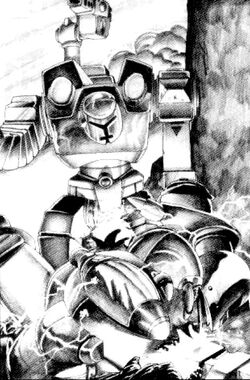
A Traitor Colossus-class robot faces off against a Loyalist Castellan-class robot during the Horus Heresy
A robot, like an Astartes Dreadnought, is the product of the synthesis of multiple advanced technologies required to construct its armoured shell, artificial muscle and nerve bundles, power plant, weapons control systems, equipment interfaces and central neural cortex.
The forges of the Adeptus Mechanicus turn out many robots of the age-old designs stored within the core memory of their logic-stacks. For example, both the Castellan and Crusader pattern robots are known to have fought on the side of both Loyalists and Traitors during the Horus Heresy. The designs have remained virtually unchanged since that time, with perhaps only minor cosmetic differences and variations.
The compatibility of the near-identical components shared with the Dreadnought simplifies many supply and repair problems on the battlefield. It is not unknown for Legio Cybernetica cohorts to have been cannibalised out of existence to provide spare parts for Dreadnoughts.
In return, Legio Tech-adepts have not been adverse to dismantling Dreadnoughts, sometimes killing its occupant in the process, when making battlefield repairs. As might be imagined, such actions are not well-regarded by any Space Marine Chapter which should catch a Legio Tech-adept actually killing a Dreadnought Battle-Brother to save his or her mechanical "pets."
Cortex and Programming[]
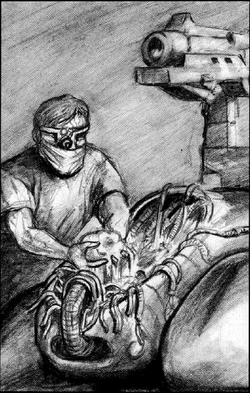
A Legio Cybernetica Tech-adept performing routine maintenance on a Castellan-class robot's neural cortex
Constructed from artificially engineered neuroproteins and enzymes, the cortex is the artificial brain of a robot. Imprinted with simple maintenance, task and movement algorithms, the cortex serves as a rudimentary mind, enabling the robot to obey simple instructions from its assigned Tech-adept when away from the battlefield.
These "firmware" routines are often patterned after those which exist in the organic neural cortexes of simple living creatures. It is known that a robot commonly develops a canine-like devotion to its technician-master.
Before deploying a robot into battle the firmware routines are overlaid and replaced with so-called "wetware"; this is the robot's combat software which defines the commands of its handler. For example, wetware contains a set of algorithms that tell a robot where it is to deploy on the battlefield or when to fire its weapons or detonate its self-destruct charges.
This specialised software is held in small slices of bioplastic, no larger than a credit card, which have been implanted within the robot's cortex. Believed by the Tech-priests of the Mechanicus to hold the robot's "soul", its Machine Spirit, many warriors on the battlefield are known to take these small bioplastic cards from a "dead" robot that has been incapacitated. They believe that by doing so, some of the robot's bravery will pass onto them. Even some Astartes Chapters have been known to abide by this tradition.
In many situations a robot may be less effective than a living warrior, even though its reflexes and aim may be comparable, and it is a stronger, tougher and harder opponent to "kill" than a human soldier. Literal-minded to an inhuman degree, a robot is limited by its programming.
Whatever the given situation, a robot always follows its pre-prepared programming, even when such programming will not produce the correct outcome for a given situation. Where a human can easily adapt to unexpected developments, a robot may not possess the mental adaptability required to successfully navigate the demands of a rapidly changing battlefield.
Like any other weapon system, a robot without its cortex is as useless as a Bolter without its Space Marine. Without an operational cortex the robot is merely a heap of junk that can only take whatever punishment is meted out to it, but with a fully programmed cortex, a robot can prove itself the equal of many other opponents on the battlefield.
Slave and Master Systems[]
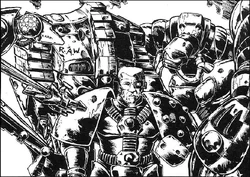
A Techmarine operator of the Desert Lions Chapter and his maniple of Imperial Robots
In some situations robots do not need a cortex to be fully operational, as they also possess the ability to act as the "slave" of a "master" robot, receiving orders by wireless radio communication from the master robot. The master robot is fitted with a cortex and wetware program, which in turn, relays algorithmic instructions to the slave robots fitted with standard Vox communicators.
Each of these slave robots follows the instructions of the master's program in turn. But the master robot must remain in close proximity to its slave robots, for if it were to move beyond the effective range of its Vox transmitter the other robots would simply freeze in place, lacking the necessary instructions to carry out any operations.
Should six or more of its communicator signals be jammed, a slave robot cannot perform any actions, and will freeze in place until further instructions are received. If the master robot's program or cortex are damaged all of its slave robots are affected equally. Communicator damage to a slave robot means that it can no longer receive or transmit data, grinding to an immediate halt. Any damage to a master robot's communicator brings all its slave robots to a halt. Any other damage to the master robot's other systems has no effect on its slaves.
Any number of slave robots can be controlled by a single master robot, although the usual ratio is 1 master to 3 slaves. When a larger ratio is used, damage to a master robot's program can halt too many slave robots in a single stroke.
Notable Members[]
- Mech-Lord Gergerra Rei - Gergerra Rei was a Mech-Lord, possessing a high status as the master of the Kapekan Sect of the Mechanicum's Legio Cybernetica branch. During the Great Crusade in the late 30th Millennium, he led two full cohorts of combat automata (Imperial Robots) which fought alongside the Luna Wolves Space Marine Legion and the Warmaster Horus during many notable campaigns. Like many members of the Cybernetica, Rei eschewed the gross cybernetic augmentations of his colleagues in the Mechanicum in favour of subtle enhancements that did not disfigure or dilute his outwardly human aspect. However, those who knew Rei knew that whatever humanity he did show was rare and fleeting. He maintained a personal bodyguard that consisted of a maniple of three modified Crusader-class robots that were in his presence at all times. A fourth mechanical, this one custom-built to resemble a female form rendered in polished chrome, walked at his side and served as his aide. No one asked questions about loyalty when Rei was nearby. His machines could hear a whisper among a roaring crowd, and those who dared to suggest aloud that Rei was anything less than the Emperor's obedient servant lived to regret it. Gergerra Rei had been involved in the creation of the Furious Abyss, a unique Imperial Abyss-class Battleship of special configuration, created and built in the Jovian shipyards of Thule by the Renegade Dark Mechanicus faction loyal to Kelbor-Hal, the Fabricator-General of Mars' Mechanicum. Though he was duplicitous in committing treason against the Imperium, he did so in a way that could not be proven without doubt in a court of law, nor in a way that connected him through any direct means, yet his involvement was enough that the guardians of the Imperium were certain of his treachery. Whatever his crime, perhaps the transfer of certain bribes, the diversion of materials and manpower or the granting of passage to starships that should have been denied, the Kapekan Mech-Lord had done the bidding of the traitor Horus Lupercal. Aboard Saros Station, an orbiting resort platform where the Mechanicum's Jovian elite could find respite and diversion from the works of the shipyards and manufactoria, Gegerra Rei met his ultimate fate at the skillful hands of the assassin known as Koyne, a Shade in the service of the Clade Callidus. Having been a shape-changer for most of his/her life, Koyne often stayed in the form necessary for the completion of the mission and eventually had forgotten his/her original gender. Disguised as a famous female opera singer, Koyne seduced the Mech-Lord and murdered him in cold blood, delivering the Emperor's justice for his betrayal.
- Xi-Nu 73 - Xi-Nu 73 was a Tech-adept of the 9th Maniple, Carthage Cohort of the Legio Cybernetica, attached to the 1301st Expeditionary Fleet of the Word Bearers Space Marine Legion during the Great Crusade of the 30th Millennium. This Imperial fleet was commanded by Seventh Captain Argel Tal of the XVII Legion's Serrated Suns Chapter. Like many of his Mechanicum counterparts, Xi-Nu 73 had undergone extensive cybernetic enhancement, improving himself a great deal over two standard centuries of loyal service to the Imperium. Carthage Cohort was comprised of dozens of maniples, of which Xu-Nu's four robotic wards were just one. The war machines and expert technical crews of Carthage Cohort were spread across the many Word Bearers fleets, rather than housed on their own Mechanicum vessels the way the Titan Legions were. Lorgar’s own insistence made it thus. The Carthage Primacy which gave this honour to the cohort had been signed and oathed over a century before the events of the Horus Heresy. The Carthage Cohort, one of the Legio Cybernetica’s proudest armies, would march with the XVII Legion, and dwell in the bowels of their vessels. Since that time, almost a dozen of Carthage Cohort's war machines had been inducted as honorary Legionaries of the Word Bearers. Xi-Nu 73 had not been present at the time this ancient oath was sworn -- he had not even been flesh-born. But despite how useful the Carthage Cohort was to the Word Bearers Legion, the Astartes simply did not like the Mechanicum element in their midst. Relations were closer to cold than cordial, even taking the Mechanicum's inhumanity into consideration. Over time, Xi-Nu 73 -- who had most humbly risen to oversee a maniple of four robots within the Cohort -- came to realise that the Word Bearers were not like their Astartes brothers. It was an opinion shared by others of his rank, on those increasingly rare occasions he established contact with them. To Xi-Nu's perception, the principal problem was that the Word Bearers were too human; fuelled by emotion, rather than logic, which affected their tactical decisions and their very goals in the Great Crusade. Despite his personal misgivings, Xi-Nu 73 loyally served the Serrated Sun Chapter during many notable campaigns until the coming of the Heresy and the corruption of the XVII Legion by the Dark Gods.
Sources[]
- Codex: Adeptus Mechanicus (8th Edition), pg. 42
- Codex: Adeptus Mechanicus - Cult Mechanicus (7th Edition), pp. 8, 10, 16-19, 23, 29, 36, 54, 82, 106-107, 171, 188
- Horus Heresy: Collected Visions (Art Book), pp. 92, 131, 304, 326, 328, 384, 392, 402, 405, 412
- Realm of Chaos: Slaves to Darkness (1st Edition), pg. 240
- The Horus Heresy - Book Two: Massacre (Forge World Series) by Alan Bligh, pp. 264-275
- The Horus Heresy - Book Three: Extermination (Forge World Series) by Alan Bligh, pp. 212-213, 223, 226
- Warhammer 40,000 Compendium (1st Edition), "Imperial Robots," pp. 67, 96-112
- White Dwarf 104 (UK), "Chapter Approved: Imperial Robots," by Mike Brunton
- A Thousand Sons (Novel) by Graham McNeill, pp. 101, 103, 107, 115, 246
- First Heretic (Novel) by Aaron Dembski-Bowden, pp. 9, 43, 100-102, 104, 108, 114, 186, 187-193, 195, 203, 234, 236, 425-429
- Nemesis (Novel) by James Swallow, pp. 126-127, 129, 132, 133-136, 138
- The Talon of Horus (Novel) by Aaron Dembski-Bowden

